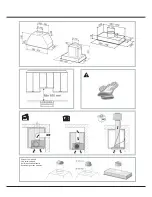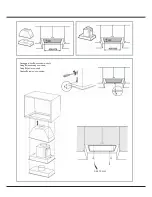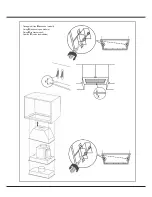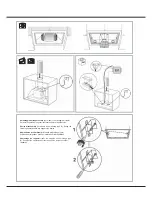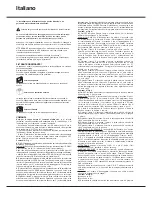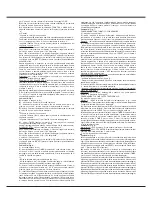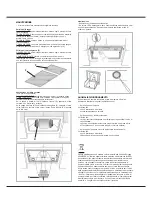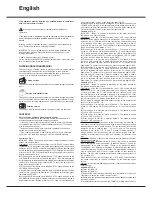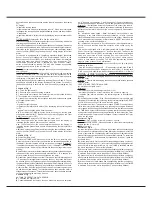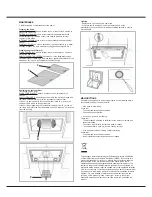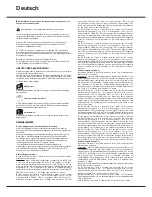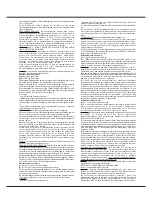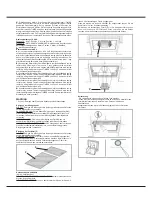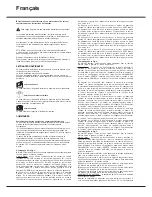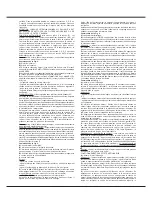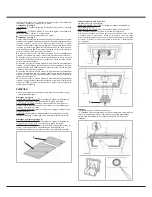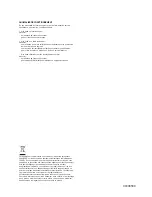
Automatic mode the sensor is active and the letter “A” appears on the display
(L).
L) Display:
- signals the running speed
- signals Automatic mode by displaying the letter “A”. When the motor speed
is changed, the running speed is displayed flashing 3 times, and then the letter
“A” reappears.
- signals the filter alarm (with motor off) by displaying the central segment for
30".
FILTER ALARM: Displayed for 30" when the motor is off:
After 30h of operation the central segment lights up on the display; It indicates
that the grease filters need to be cleaned.
After 120h of operation, the central segment flashes on the display; It indicates
that the grease filters need to be cleaned and the charcoal filters replaced.
After cleaning the grease filters (and/or replacing the charcoal filters), restart
the hour counter (RESET) by pressing the key C during display of the filter
alarm.
This device is equipped with a completely automatic system (Advanced
Sensor Control) for management of all hood functions. Thanks to the
Advanced sensor Control (ASC), air circulating in the kitchen is maintained
clean and odour-free without requiring any user intervention. The
sophisticated sensors are able to capture any type of odour, vapour,
smoke or heat caused by cooking. The ASC also captures any possible
irregular gases present in the environment.
Warning: in order to avoid damaging the sensor, never use silicone products
near the hood!
GAS SENSOR SENSITIVITY: The sensitivity of the sensor can be modified
to suit your requirements. To modify the sensitivity, the appliance must be
in manual mode (i.e. the running speed and not the letter “A” must appear on
the display); If not, press the key E.
Modify the sensitivity by simultaneously pressing the keys D and E. The set
sensitivity is indicated on the display. By means of the buttons C(-) and D(+)
the desired sensitivity is set Store the “new” sensitivity by pressing the key
E.
Controls of Fig. 5:
A) : Turns the lights on/off.
B) : Reduces and increases lighting intensità.
C) : reduces the motor speed until reaching minimum. If pressed for about
2", it stops the motor and storse the speed.
D) : drives the motor (calling the last speed used) and increases the speed
until reaching maximum.
L Display:
- signals the running speed.
- signals the filter alarm (with motor off) by displaying the central segment
for 30".
- signals Timer activation with a flashing number.
Key E : activates the TIMER (when the motor is running), so that the hood
stops automatically after 5'. Also Zero-sets hour metering when the Filter
Alarm is active (motor OFF).
FILTER ALARM: Displayed for 30" when the motor is off:
After 30h of operation, the central segment lights up on the display; It
indicates that the grease filters need to be cleaned.
After 120h of operation, the central segment flashes on the display; It
indicates that the grease filters need to be cleaned and the charcoal filters
replaced.
After cleaning the grease filters (and/or replacing the charcoal filters), restart
the hour counter (RESET) by pressing the key E during display of the filter
alarm.
Controls of Fig. 6:
A): turns the lights on/off.
B): turns the TIMER on/off: press once to turn the timer on, therefore, after
5 minutes, the motor cuts out (at the same time the selected speed blinks on
the display); the timer remains on if the motor speed is changed. Display C):
- indicates the selected motor speed (from 1 to 4); - indicates Timer On when
the number blinks; - indicates Filter Alarm when the central segments is on or
blinking.
D): makes the motor work (at the last speed selected); pushing the button again,
the speeds of the motor are sequentially selected from 1 to 4; keeping this
button pressed for about 2 seconds shuts down the motor.
R): resets the grease filters or charcoal filters; when the filter alarm appears
(i.e. when the central segment on the display goes on), the grease filters must
be cleaned (30 hours of operation); when the central segment starts blinking,
the grease filters must be cleaned and the charcoal filters replaced (120 hours
of operation). Obviously, if the hood is not a filtering model and does not have
a charcoal filter, clean the grease filters both when the central segment goes
on and when it starts blinking. The filter alarm can be seen when the motor is
off and for about 30 seconds. To reset the hour counter, keep the button pressed
for 2 seconds while the alarm can be seen.
Controls of Fig. 7:
AUTOMATIC OPERATION WITH SENSOR:
A) : switches the lights on/off.
B) : enables/disables “Automatic” function. When this function is selected,
an “A” appears on the display C, and the speed of the motor increases or
decreases depending on the smoke, odours and gas present in the kitchen.
Display C) : - indicates the automatic operation of the sensor (the letter “A”
appears);- indicates the motor speed selected automatically by the sensor;
indicates the filter alarm whenever the central segment is illuminated or
flashing.
D) : decreases motor speed / Reset; decreases motor speed to zero
(stopping); in any case however, after approximately 1 minute, the hood
resumes automatic operation at the speed set by the sensor. Whenever the
key is pressed during the display of filter alarms, a RESET occurs, and the
counting of the hours resumes again.
E) : increases motor speed; in any case however, after approximately 1
minute, the hood resumes automatic operation at the speed set by the
sensor.
This device is equipped with a completely automatic system (Advanced
Sensor Control) for management of all hood functions. Thanks to the
Advanced sensor Control (ASC), air circulating in the kitchen is maintained
clean and odour-free without requiring any user intervention. The
sophisticated sensors are able to capture any type of odour, vapour,
smoke or heat caused by cooking. The ASC also captures any possible
irregular gases present in the environment.
Modification of sensor sensitivity: sensor sensitivity can be modified by
operating as follows:
- stop the hood by pressing key B. – Simultaneously press keys D and E
(the sensor’s sensitivity index will appear on the display) - Pressing keys
D or E, the sensor’s sensitivity will either increase or decrease (1 : minimum
sensitivity / 9: maximum sensitivity). – whenever the power supply is
interrupted, the sensor will resume operation with a sensitivity index of 5.
Warning: in order to avoid damaging the sensor, never use silicone products
near the hood!
Warning: in order to avoid damaging the sensor, never use silicone products
near the hood!
OPERATION AS TRADITIONAL HOOD:
A) : switches the lights on/off.
Display C) :
- indicates the motor speed selected (from 1 to 4);
- indicates the operation of the Timer when the number is flashing;
- indicates filter alarms whenever the central segment is illuminated or
flashing.
D) : decreases motor speed / Stop / Reset; decreases motor speed to zero
(stopping). Whenever the key is pressing during filter alarm display, a RESET
occurs, and the counting of the hours resumes again.
E) : enables the motor / increases motor speed /TIMER. Pressing this key
starts the motor (at the latest speed set); pressing the key again increases
motor speed, while keeping the key pressed down for a few seconds enables
the TIMER, and 5 minutes later the motor will stop (while the number of speed
setting selected will simultaneously begin flashing on the display); the Timer
will remain enabled if motor speed is changed. In order to disable the Timer,
press the key again.
Controls of Fig. 8:
Switch A: LIGHT; position 0: light off; position 1: light on.
Switch B: MOTOR SPEED: makes it possible to select the motor operating
speed; position 0: motor off.
C: Motor on light.
Controls of Fig. 9:
A): turns the lights on/off; every 30 hours of operation the corresponding pilot
lamp comes on to indicate that the grease filters must be cleaned; every 120
hours of operation the corresponding pilot lamp flashes to indicate that the
grease filters must be cleaned and the charcoal filter replaced. To restart the
hour counter (RESET), hold the button A pressed down for about 1” (while the
pilot lamp is on).
B): drives the motor in first speed (the corresponding pilot lamp comes on);
when holding it down for about 1”, the motor cuts out; when pressing the button
a second time (while the pilot lamp is on) , the TIMER is activated and thus
the motor stops after 5’ (the pilot lamp flashes).
C): drives the motor in second speed (the corresponding pilot lamp comes on);
when pressing the button a second time (while the pilot lamp is on) , the TIMER
is activated and thus the motor stops after 5’ (the pilot lamp flashes).
D): drives the motor in third speed (the corresponding pilot lamp comes on);
when pressing the button a second time (while the pilot lamp is on) , the TIMER
is activated and thus the motor stops after 5’ (the pilot lamp flashes).
E): drives the motor in fourth speed (the corresponding pilot lamp comes on);
when pressing the button a second time (while the pilot lamp is on) , the TIMER
is activated and thus the motor stops after 5’ (the pilot lamp flashes).


